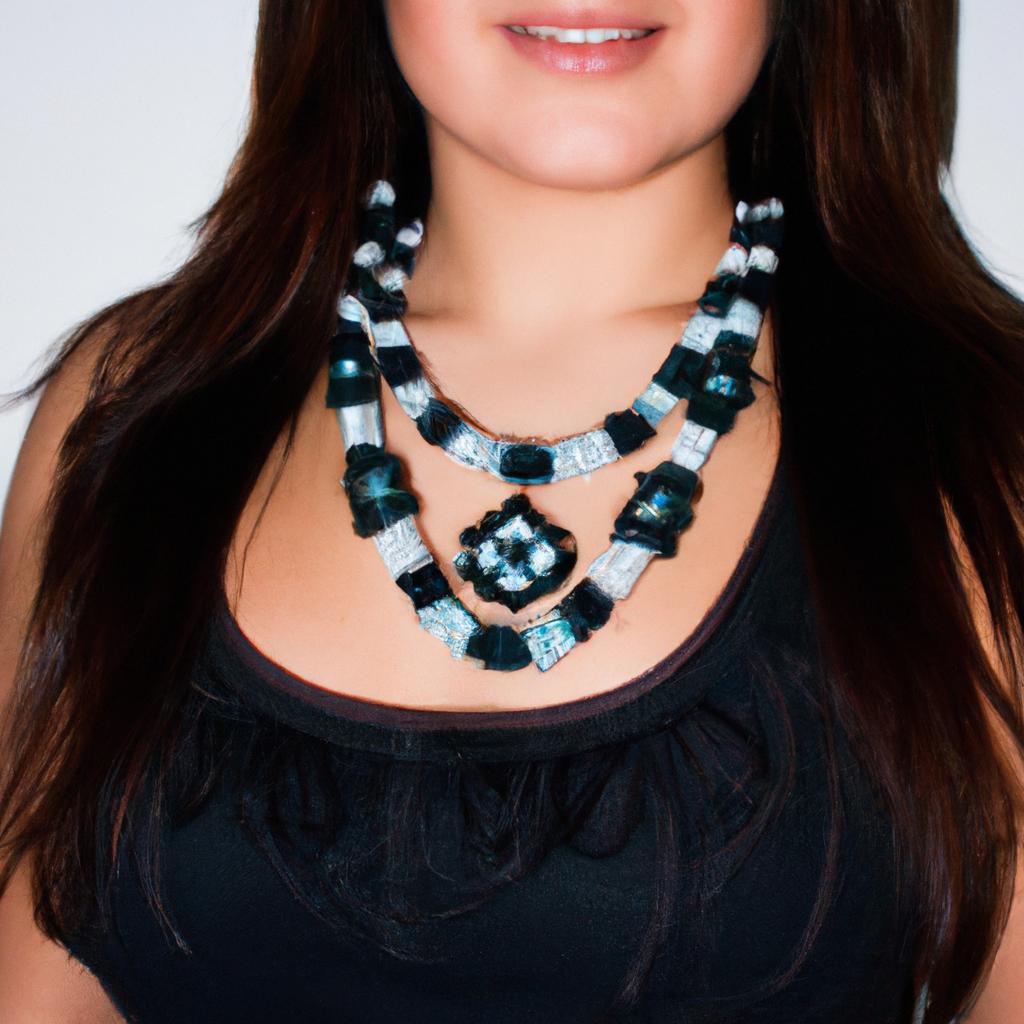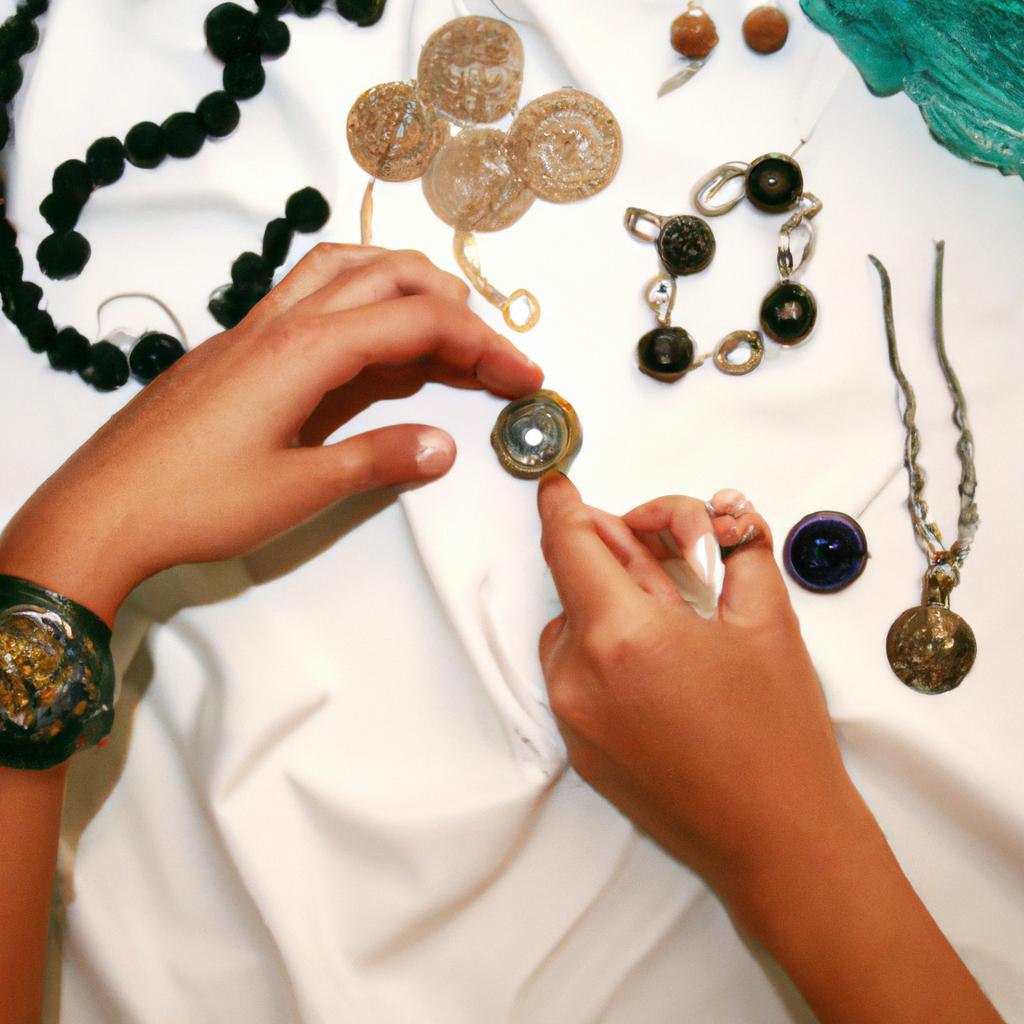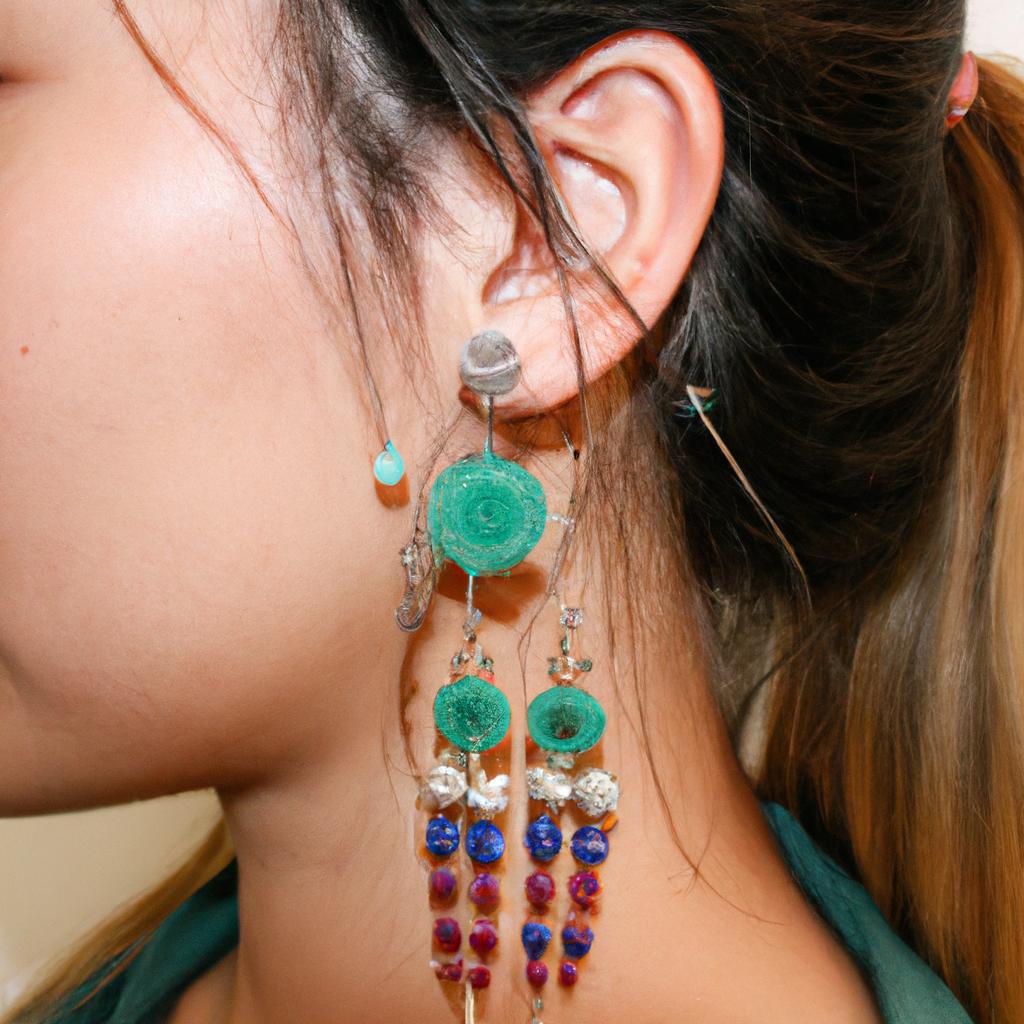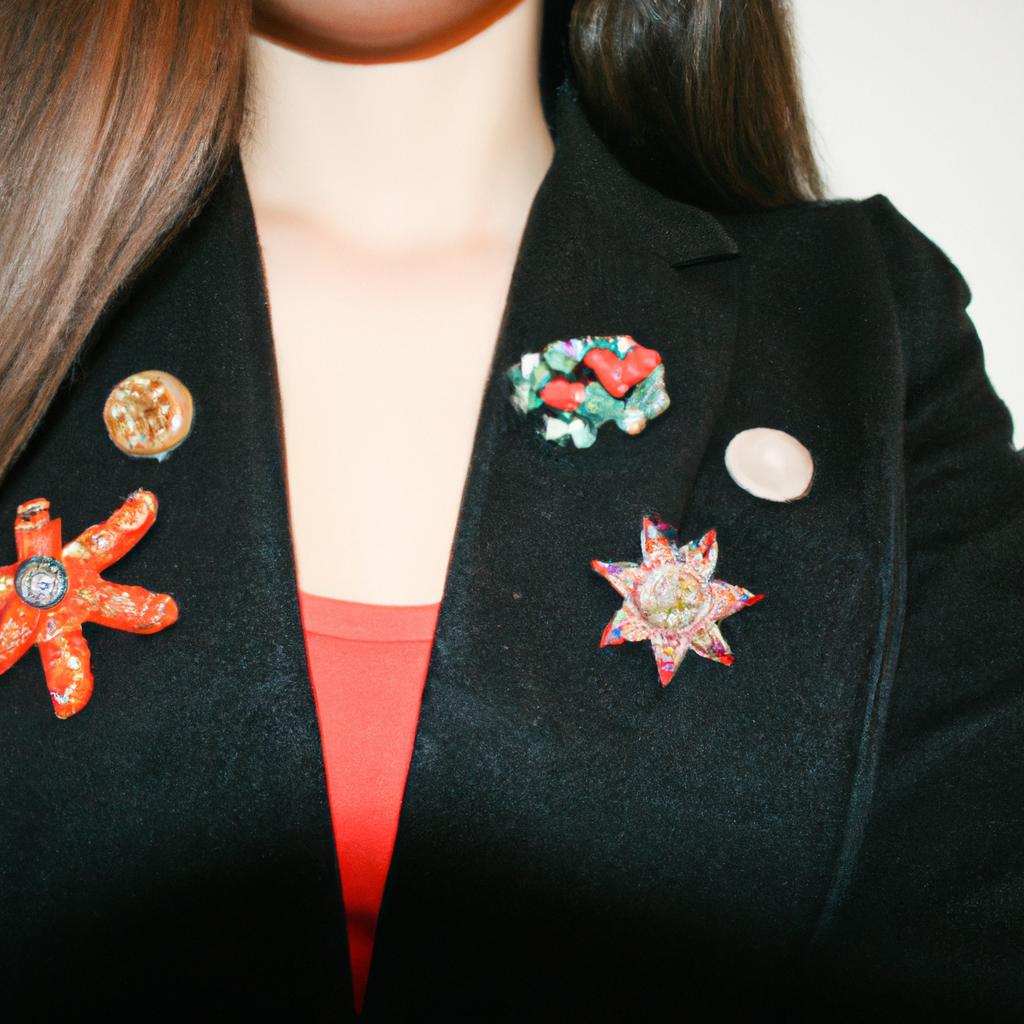Rings have long been cherished as exquisite pieces of jewelry that adorn the fingers and symbolize various aspects of human life. From ancient times to the present day, rings have held cultural significance across different societies and are often associated with notions of love, commitment, power, and social status. For instance, consider a hypothetical scenario where an individual is presented with an engagement ring by their partner. This gesture not only signifies the promise of lifelong companionship but also encapsulates societal expectations surrounding marriage and partnership.
Exploring the world of rings reveals a rich tapestry of designs, materials, and meanings that captivate both wearers and admirers alike. In addition to their aesthetic appeal, rings serve as potent symbols in diverse contexts. Take for instance the signet ring worn by kings and nobles throughout history; this accessory conveyed authority, identity, and allegiance within ruling circles. Similarly, wedding bands represent unity between couples while showcasing personal style preferences. Beyond these traditional associations, contemporary fashion trends have expanded the range of ring styles available today – from minimalist geometric designs to intricate gemstone settings – allowing individuals to express their unique personalities through their choice of accessories.
This article delves into the multifaceted world of rings: exploring their historical origins, examining the symbolism they carry, and discussing the different types of rings that exist today. By understanding the significance behind these timeless pieces, we can fully appreciate their cultural, emotional, and artistic value.
Historically, rings have been used as a means of communication and expression since ancient times. The earliest evidence of ring-wearing dates back to ancient Egypt, where rings were worn as symbols of power and authority by pharaohs and high-ranking officials. In addition to their decorative purposes, rings were also used for practical reasons such as sealing documents with personalized signet rings.
Throughout history, various cultures have attributed different meanings to rings. In ancient Rome, for example, wedding bands symbolized eternal love and commitment between spouses. In some cultures, particularly in Asia, thumb rings were worn by archers to enhance their grip on the bowstring. And in many Western societies today, wearing a class ring is seen as a proud symbol of educational achievement.
The materials used in ring-making have also played a significant role in their symbolism. For instance, gold has long been associated with wealth and prosperity while silver is often linked to purity and elegance. Precious gemstones like diamonds are commonly incorporated into engagement rings due to their association with everlasting love.
In recent years, there has been an increasing trend towards personalized or custom-designed rings. This allows individuals to create unique pieces that reflect their own tastes and values. From birthstone rings representing one’s birth month to family heirlooms passed down through generations, customized designs add an extra layer of sentimentality to these cherished accessories.
In conclusion, the world of rings is vast and diverse – spanning across cultures, traditions, and personal preferences. Whether it’s an engagement ring symbolizing lifelong commitment or a fashion statement reflecting individual style choices, rings carry profound meaning for those who wear them. Exploring this fascinating realm reveals not only the beauty and craftsmanship behind these adornments but also the rich tapestry of human emotions and aspirations they represent.
History of Rings
Rings, a ubiquitous form of jewelry accessory, have been worn by various cultures for centuries. They hold deep historical and cultural significance, serving as symbols of love, power, and status. For instance, in ancient Egypt, rings were not only fashionable but also had practical uses; they were used as seals to authenticate documents or mark ownership. This example demonstrates the multifaceted nature of rings throughout history.
To better understand the evolution of rings, it is important to explore their distinctive features and symbolism across different time periods and civilizations. Here are some key aspects worth considering:
- Materials: Rings have been crafted from diverse materials such as gold, silver, bronze, gemstones, and even bone or wood. Each material carries its own symbolic associations and aesthetic appeal.
- Designs: The design elements incorporated into rings vary widely depending on the era and culture. Intricate engravings, filigree work, or motifs inspired by nature can be found in many historical ring designs.
- Symbolism: Rings often serve as potent symbols that convey messages about personal identity or social standing. They may represent commitment in marriage ceremonies or signify membership within a specific group or organization.
- Functionality: Beyond their decorative value, rings have served functional purposes throughout history. Some rings featured hidden compartments for storing secret messages or substances while others contained concealed blades for self-defense.
This table provides an overview of notable ring styles from different periods:
| Period | Style | Material |
|---|---|---|
| Ancient | Signet Ring | Gold |
| Medieval | Claddagh Ring | Silver |
| Renaissance | Posy Ring | Enamel |
| Victorian | Mourning Ring | Jet |
The rich tapestry of ring history showcases how these accessories have evolved over time while maintaining their enduring allure. In the subsequent section, we will delve into the various types of rings that have emerged from this rich historical backdrop, offering a deeper understanding of their diverse forms and purposes.
Types of Rings
Exploring the Cultural Significance of Rings
Imagine a young couple exchanging vows on their wedding day, slipping matching gold bands onto each other’s fingers as a symbol of their eternal commitment. This simple act encapsulates the profound cultural significance that rings hold in our society. In this section, we will delve deeper into the emotional and symbolic value attached to these cherished accessories.
Rings have evolved over centuries to become powerful symbols of love, unity, and social status. They serve as tangible reminders of special moments, milestones, and relationships. Here are some key aspects that contribute to the emotional resonance of rings:
- Sentimental Value: Rings often carry sentimental attachments, representing treasured memories or connections with loved ones. A family heirloom passed down through generations can evoke a sense of legacy and heritage.
- Symbolism: Different cultures and societies attribute various meanings to rings. For example, an engagement ring signifies betrothal and anticipation of marriage in many Western traditions, while a signet ring may represent authority or membership in certain organizations.
- Personal Expression: Rings allow individuals to express their unique style and personality. Whether it be an intricate design showcasing one’s artistic flair or a birthstone-embedded band reflecting personal identity, rings provide a canvas for self-expression.
- Emotional Connection: The exchange or wearing of rings often fosters emotional bonds between individuals involved. It serves as a constant reminder of affectionate feelings shared between partners, friends, or family members.
To further illustrate the diversity and depth of cultural associations tied to rings, consider the following table:
| Culture | Ring Meaning | Example Use |
|---|---|---|
| Ancient Egypt | Eternal love; afterlife protection | Burial ceremonies |
| Indian | Marital commitment; auspiciousness | Wedding rituals |
| Celtic | Unity; interconnectedness | Handfasting ceremonies |
| Japanese | Promise; friendship | Graduation gifts |
As we have explored the emotional significance and cultural meanings of rings, it becomes clear that these accessories hold far more than mere material value. In the subsequent section on “Symbolism and Meanings of Rings,” we will delve deeper into how different cultures interpret the messages conveyed by various ring designs and styles. By understanding this rich symbolism, we can gain a deeper appreciation for the profound impact that rings have on our lives and relationships.
Transitioning seamlessly into the next section about “Symbolism and Meanings of Rings,” let us now explore how diverse cultures assign symbolic interpretations to specific ring designs.
Symbolism and Meanings of Rings
Types of Rings have been explored in the previous section, shedding light on the various styles and designs available. Now, we delve into the Symbolism and Meanings associated with these timeless accessories.
To illustrate the significance of rings, let us consider a hypothetical scenario: Sarah receives an ornate silver ring adorned with a delicate rose design from her grandmother on her 18th birthday. This gesture not only symbolizes their bond but also represents love, beauty, and growth. Such examples highlight how rings can hold deep emotional value and serve as tangible reminders of important relationships or milestones.
When examining the symbolism behind rings, several key themes emerge:
-
Love and Commitment:
- Rings are often exchanged during weddings to symbolize eternal love and commitment between partners.
- Engagement rings signify a promise to marry and represent the beginning of a lifelong journey together.
- Promise rings can be given as a token of devotion in a romantic relationship without the intention of immediate marriage.
-
Identity and Status:
- Class rings are commonly worn by graduates to commemorate their educational achievements.
- Signet rings historically served as symbols of authority or membership within specific social groups.
- Championship rings celebrate athletic prowess and team accomplishment.
-
Connection and Remembrance:
- Family heirloom rings pass down through generations, carrying sentimental value and connecting individuals to their ancestors.
- Friendship rings symbolize loyalty and create lasting bonds among friends.
-
Spiritual Beliefs:
- Religious or spiritual symbols incorporated into ring designs reflect personal faiths and beliefs.
- Birthstone rings connect individuals with their corresponding birth month’s gemstone believed to possess unique qualities.
Table: Symbolism Associated with Rings
| Theme | Example |
|---|---|
| Love | Wedding bands |
| Engagement rings | |
| Promise rings | |
| Identity | Class rings |
| Signet rings | |
| Championship rings | |
| Connection | Family heirloom rings |
| Friendship rings | |
| Spiritual Beliefs | Religious symbol rings |
| Birthstone rings |
In exploring the symbolism and meanings behind different types of rings, it becomes evident that these accessories possess a remarkable ability to evoke emotions, preserve memories, and communicate messages without words. They hold profound significance in various aspects of life, bridging connections between individuals and serving as enduring symbols.
With an understanding of the symbolic power inherent in rings, we now turn our attention to the Materials Used in Ring Making. This exploration will shed light on the diverse materials employed to craft these cherished adornments, each contributing its unique characteristics and aesthetic appeal.
Materials Used in Ring Making
Exploring Different Materials Used in Ring Making
As we delve further into the world of rings, it is important to understand the various materials used in their creation. While symbolic meanings and emotional significance are undeniably powerful aspects of rings, the choice of material can also greatly influence both the aesthetics and durability of these jewelry accessories.
One example that showcases the impact of materials on ring design is the use of gemstones. Imagine a stunning engagement ring adorned with a sparkling diamond as its centerpiece. The brilliance and allure of diamonds make them highly sought-after gems for symbolizing everlasting love and commitment. However, other gemstones such as sapphires or emeralds can also be used to add a unique touch to a ring while conveying different emotions or personal preferences.
To better comprehend the range of materials utilized in creating rings, let us explore some common options:
- Precious Metals:
- Gold: Known for its timeless elegance and versatility.
- Silver: Offers a sleek and modern aesthetic at an affordable price point.
- Platinum: A durable metal often chosen for its strength and hypoallergenic properties.
- Titanium: Increasingly popular due to its lightweight nature and resistance to corrosion.
Within each category, there are numerous variations in color, purity levels, and finishes that allow individuals to find their desired combination of style, durability, and affordability.
In addition to metals, alternative materials have gained popularity in recent years due to their distinctive characteristics. For instance:
| Material | Characteristics | Popular Use |
|---|---|---|
| Wood | Earthy tones; eco-friendly | Bohemian-style rings |
| Ceramic | Scratch-resistant; vibrant colors | Fashion-forward designs |
| Tungsten | Exceptional hardness; scratch-resistant | Modern wedding bands |
| Stainless Steel | Affordable; robust | Everyday wear |
This wide range of materials gives individuals the opportunity to express their personal style and preferences through their choice of ring. Whether it be a traditional gold band or an unconventional wooden design, each material offers its own unique charm.
Transitioning into our next section on popular ring styles, we will explore how these different materials are utilized in various designs to create rings that cater to every individual’s taste and fashion sense. From classic solitaires to intricate vintage-inspired settings, the world of rings truly knows no bounds when it comes to creativity and self-expression.
Popular Ring Styles
Transitioning from our previous exploration of the materials used in ring making, let us now delve into the diverse world of popular ring styles. To illustrate this, imagine a scenario where you are attending an elegant black-tie event and notice a stunning woman adorned with a dazzling diamond cocktail ring on her finger. This captivating piece exemplifies one of the many ways rings can enhance personal style and make a statement.
When it comes to selecting a ring that reflects individual taste and personality, there is an abundance of options available. Here are some popular ring styles that have captivated jewelry enthusiasts worldwide:
- Solitaire Rings: These timeless classics feature a single gemstone at their center, symbolizing elegance and simplicity.
- Halo Rings: Known for their radiant beauty, halo rings encircle a central stone with smaller diamonds or gemstones, creating a magnificent halo effect.
- Vintage-inspired Rings: Drawing inspiration from various eras like Art Deco or Victorian periods, these rings exude nostalgic charm and intricate detailing.
- Stackable Rings: Perfect for those seeking versatility, stackable rings offer endless possibilities by allowing wearers to mix and match multiple bands according to personal preference.
To further explore the allure of different ring styles, consider the following emotional responses they may evoke:
| Ring Style | Emotional Response |
|---|---|
| Solitaire | Timeless elegance |
| Halo | Captivating radiance |
| Vintage-inspired | Nostalgic enchantment |
| Stackable | Versatile playfulness |
As we conclude our discussion on popular ring styles, it is evident that each design holds its own unique appeal. Whether one prefers classic sophistication or contemporary flair, there is undoubtedly something for everyone within the realm of jewelry accessories.
Looking ahead to our next section on “Caring for Your Rings,” we will explore essential maintenance practices to ensure the longevity and beauty of your cherished pieces. So, let us now transition into the realm of ring care and maintenance.
Caring for Your Rings
Transitioning from the previous section on popular ring styles, we now turn our attention to the various materials that can be used in crafting rings. Understanding these materials is crucial for selecting a ring that not only suits your personal style but also meets your desired level of durability and maintenance. Let us delve into the world of ring materials through an example:
Imagine you are searching for a unique engagement ring that symbolizes both elegance and strength. One option that may catch your eye is a titanium ring adorned with sparkling diamonds. Titanium, known for its exceptional strength-to-weight ratio, offers durability while exuding a sleek modern aesthetic. The combination of titanium’s resilience and the brilliance of diamonds creates a captivating contrast, making it an ideal choice for those seeking distinctive jewelry.
When exploring different ring materials, several factors should be considered before making your final selection. To help guide you in this process, here are some key points to keep in mind:
- Durability: Consider how well the material can withstand everyday wear and tear.
- Maintenance: Evaluate the amount of care and upkeep required to preserve the ring’s appearance.
- Allergies: Take note if any specific materials may cause allergic reactions or sensitivities.
- Style Versatility: Assess whether the material complements a variety of clothing styles and occasions.
To further illustrate these considerations, let us take a closer look at four commonly used ring materials:
| Material | Durability | Maintenance | Style |
|---|---|---|---|
| Gold | Moderate | High | Diverse range from classic to contemporary |
| Silver | Low | Moderate | Versatile and often associated with simplicity |
| Platinum | High | Low | Elegant and timeless |
| Stainless Steel | High | Low | Modern and affordable |
By weighing each material’s characteristics against your preferences, you can make an informed decision that aligns with your needs and desires. Whether you prioritize durability, ease of maintenance, or a specific style aesthetic, understanding the characteristics of different materials will help guide you towards choosing the perfect ring.
In summary, exploring the world of ring materials is an essential step in finding your ideal jewelry piece. By considering factors such as durability, maintenance requirements, allergies, and style versatility, you can narrow down your options to find a material that suits both your personal taste and practicality. With this knowledge at hand, let us now delve into caring for your rings in our next section.
 Shanes Jewelry
Shanes Jewelry



